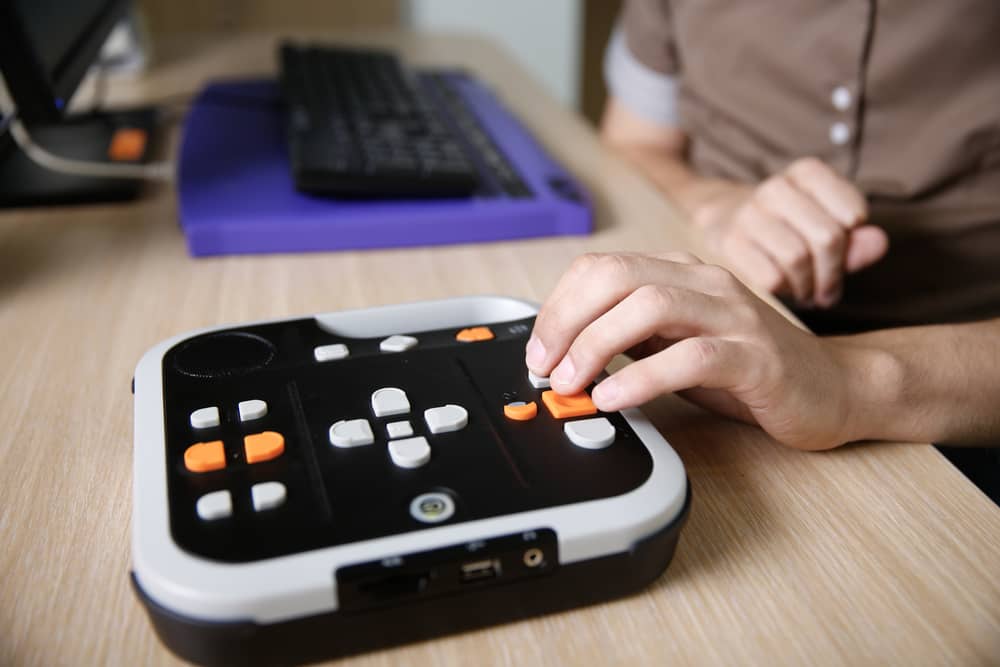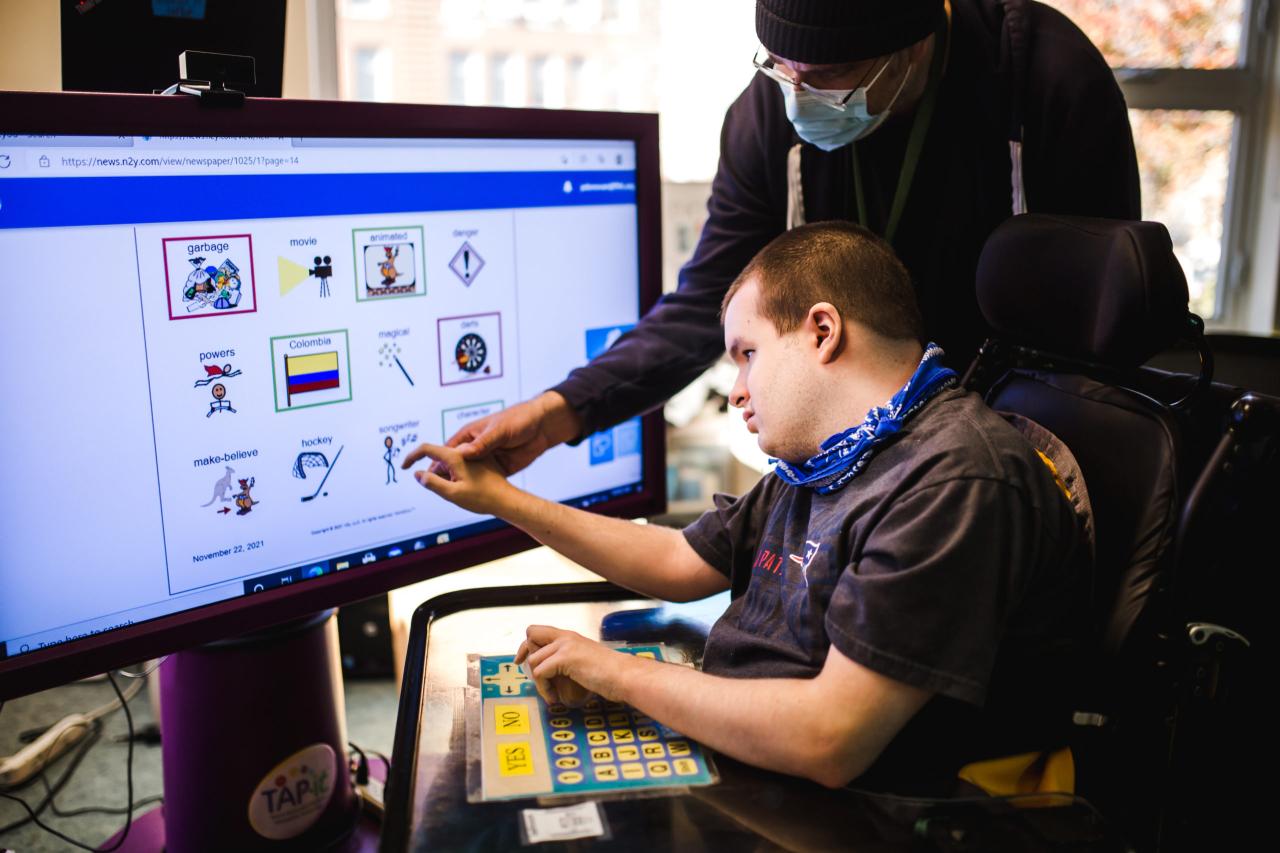Assistive Technology for Intellectual Disabilities: Empowering Inclusion
Assistive technology for intellectual disabilities is a powerful tool that can transform lives, fostering independence, inclusion, and a greater sense of self-worth. Individuals with intellectual disabilities often face unique challenges […]

Assistive technology for intellectual disabilities is a powerful tool that can transform lives, fostering independence, inclusion, and a greater sense of self-worth. Individuals with intellectual disabilities often face unique challenges in communication, learning, and daily living, but with the right assistive technology, they can overcome these obstacles and achieve their full potential.
From specialized communication devices to adaptive learning platforms, assistive technology provides a bridge to greater understanding, engagement, and participation in all aspects of life. It empowers individuals to communicate their thoughts and feelings, access education and information, and engage in meaningful activities, ultimately leading to a more fulfilling and empowered life.
Learning Assistive Technology
Assistive technology plays a crucial role in empowering individuals with intellectual disabilities to thrive in their learning journey. By providing tailored support, these technologies bridge gaps and unlock their full potential, fostering a more inclusive and equitable learning environment.
Examples of Educational Software, Assistive Tools, and Adaptive Learning Platforms
Educational software, assistive tools, and adaptive learning platforms are designed to address specific learning needs and enhance accessibility. These technologies offer a range of features, including:
- Speech-to-Text Software: Converts spoken words into written text, aiding individuals with reading difficulties or dyslexia. This technology allows them to participate in discussions, take notes, and access written materials more easily.
- Text-to-Speech Software: Reads digital text aloud, enabling individuals with visual impairments or reading difficulties to engage with written content. This software can be used for textbooks, articles, and other learning materials.
- Visual Aids: Includes tools like graphic organizers, mind maps, and visual timers, which help individuals with visual processing challenges to organize information, improve memory, and manage time effectively.
- Adaptive Learning Platforms: Provide personalized learning experiences tailored to individual needs and pace. These platforms track student progress, identify areas of strength and weakness, and adjust the difficulty level accordingly.
- Assistive Communication Devices: Enable individuals with communication challenges to express themselves through alternative methods, such as picture exchange systems (PECS), augmentative and alternative communication (AAC) devices, or speech-generating devices.
Impact of Assistive Technology on Cognitive Development, Academic Achievement, and Personal Growth
Assistive technology has a profound impact on the cognitive development, academic achievement, and personal growth of individuals with intellectual disabilities. It fosters:
- Enhanced Cognitive Development: By providing tailored support and scaffolding, assistive technology helps individuals develop essential cognitive skills, such as memory, attention, problem-solving, and critical thinking. This, in turn, enhances their overall cognitive abilities.
- Improved Academic Achievement: Assistive technology empowers individuals to overcome learning barriers and access the curriculum more effectively. This leads to improved academic performance, increased confidence, and a greater sense of accomplishment.
- Increased Independence and Self-Esteem: By providing tools and strategies to navigate their learning environment, assistive technology promotes independence and self-efficacy. This fosters a sense of empowerment and enhances their self-esteem.
- Enhanced Social Inclusion: Assistive technology facilitates participation in group activities, promotes communication, and fosters social interactions. This leads to greater social inclusion and a sense of belonging within the learning community.
Accessibility and Usability

Assistive technology (AT) is designed to empower individuals with disabilities, enabling them to participate fully in various aspects of life. However, the effectiveness of AT hinges on its accessibility and usability. These two principles are intertwined, ensuring that technology is not only available but also user-friendly and adaptable to individual needs.
User-Centered Design
User-centered design is a crucial principle in assistive technology development. It emphasizes understanding the needs, abilities, and limitations of the target users. By involving individuals with disabilities in the design process, developers can gain valuable insights into their experiences and preferences. This collaborative approach ensures that AT is tailored to the specific requirements of its intended users.
- Focus on User Needs: AT should address the specific challenges faced by individuals with disabilities, whether it’s visual impairment, hearing loss, cognitive limitations, or physical impairments.
- Emphasize User Input: Involving users in design discussions, testing, and feedback sessions ensures that the final product meets their needs and expectations.
- Iterative Development: The design process should be iterative, allowing for continuous improvement based on user feedback and testing.
Intuitive Interfaces
Intuitive interfaces are essential for assistive technology to be truly usable. This means that the technology should be easy to understand and navigate, even for individuals with limited experience or cognitive abilities. Complex interfaces can create barriers to access and hinder the effectiveness of AT.
- Simple and Clear Design: The interface should be visually uncluttered and use simple language and icons that are easily recognizable.
- Logical Navigation: The layout and flow of the interface should be intuitive, allowing users to navigate easily between different features and functions.
- Consistent Design Elements: Using consistent design elements, such as buttons, menus, and icons, helps users learn the interface quickly and efficiently.
Customization Options
Customization options are essential for making assistive technology adaptable to individual needs and preferences. Users should be able to adjust settings, personalize features, and configure the technology to best suit their unique circumstances.
- Adjustable Settings: AT should offer adjustable settings for font size, color contrast, and other visual and auditory parameters to accommodate individual preferences and disabilities.
- Personalization Features: Allowing users to personalize the interface, such as changing themes or adding shortcuts, enhances user satisfaction and promotes long-term use.
- Compatibility with Existing Systems: Ensuring compatibility with other assistive technologies, operating systems, and software programs promotes seamless integration and reduces barriers to use.
Examples of Accessible Assistive Technology
Numerous assistive technologies effectively address accessibility challenges. Here are a few examples:
- Screen Readers: Screen readers convert text on a computer screen into synthesized speech, allowing individuals with visual impairments to access digital content. Popular screen readers include JAWS, NVDA, and VoiceOver.
- Magnification Software: Magnification software enlarges the display on a computer screen, making it easier for individuals with low vision to read text and see images. Examples include ZoomText, MAGic, and SuperNova.
- Speech Recognition Software: Speech recognition software allows users to control their computers and other devices using their voice, providing an alternative to keyboard and mouse input. Examples include Dragon NaturallySpeaking, VoiceNote, and Windows Speech Recognition.
- Alternative Input Devices: Alternative input devices, such as eye-tracking systems, head-mounted pointers, and mouth sticks, provide alternative ways for individuals with physical impairments to interact with computers and other devices.
Funding and Resources

Securing funding for assistive technology is crucial for individuals with intellectual disabilities to access the tools and support they need to live fulfilling lives. Various sources can help cover the costs, and understanding these options can be a vital step in the journey towards greater independence and inclusion.
Government Programs
Government programs play a significant role in providing financial assistance for assistive technology. These programs often target specific needs and demographics, and individuals with intellectual disabilities are eligible for a range of benefits.
- The Individuals with Disabilities Education Act (IDEA): This federal law mandates that states provide special education and related services to eligible children with disabilities, including assistive technology. The law ensures that children have access to the tools they need to succeed in school and participate in their communities.
- The Social Security Administration (SSA): The SSA offers various programs that can assist individuals with disabilities, including financial assistance for assistive technology. These programs aim to help individuals maintain their independence and quality of life.
- The Department of Veterans Affairs (VA): The VA provides a range of benefits to veterans with disabilities, including financial assistance for assistive technology. These benefits can help veterans access the tools they need to adapt to their disability and live fulfilling lives.
Insurance Coverage
Private insurance plans can also provide coverage for assistive technology. However, coverage can vary depending on the specific plan and the type of assistive technology needed. It is crucial to carefully review insurance policies and contact insurance providers to understand coverage limitations and eligibility requirements.
- Health Insurance Plans: Many health insurance plans cover assistive technology deemed medically necessary. These plans may cover devices like wheelchairs, hearing aids, or communication aids, depending on the individual’s needs and the specific policy terms.
- Disability Insurance: Disability insurance plans can also provide coverage for assistive technology. These plans often cover devices that help individuals maintain their independence and ability to work.
Charitable Organizations, Assistive technology for intellectual disabilities
Charitable organizations play a vital role in supporting individuals with intellectual disabilities by providing financial assistance, equipment, and other resources. These organizations often focus on specific needs and can provide tailored support to individuals and families.
- The Arc: The Arc is a national organization that advocates for and supports people with intellectual and developmental disabilities. They offer various programs, including financial assistance for assistive technology, and provide resources and support to families.
- United Cerebral Palsy (UCP): UCP is another national organization that provides support and resources to individuals with cerebral palsy and other disabilities. They offer programs that provide financial assistance for assistive technology, as well as training and advocacy services.
- Easter Seals: Easter Seals is a national organization that provides a range of services to individuals with disabilities, including assistive technology. They offer financial assistance, equipment, and support services to help individuals achieve greater independence and inclusion.
Conclusion: Assistive Technology For Intellectual Disabilities

As technology continues to evolve, the potential for assistive technology to enhance the lives of individuals with intellectual disabilities grows exponentially. By embracing innovation and promoting accessibility, we can create a world where everyone has the opportunity to thrive and contribute to society. Let’s work together to ensure that assistive technology becomes a cornerstone of inclusion and empowerment for all.
Assistive technology plays a crucial role in empowering individuals with intellectual disabilities to lead fulfilling lives. From communication aids to adaptive tools, these technologies can bridge gaps and unlock potential. For those seeking a career in the beauty industry, nail technology scholarships can provide financial support, making it more accessible for individuals with intellectual disabilities to pursue their passion.
This demonstrates how education and assistive technology can work hand-in-hand to create opportunities for everyone.




